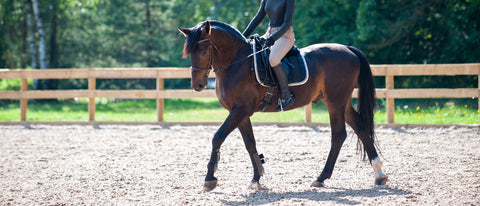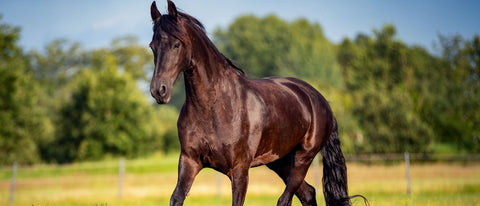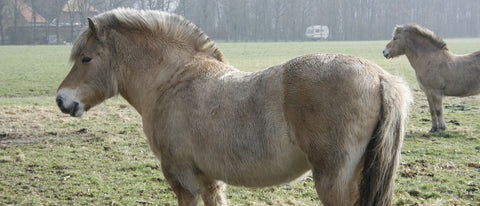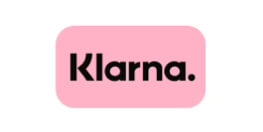
Florian ist aufgewachsen auf einem Bauernhof. Umgeben von Pferden, entdeckte er früh seine Faszination für diese majestätischen Tiere. Inspiriert von seiner reitbegeisterten Mutter, entwickelte er das Nahrungsergänzungmittel - Pferdegold. Seine tiefe Verbundenheit zur Natur und die leidenschaftliche Hingabe zu Pferden trieben ihn an, sein Unternehmen zu gründen.
Calmness training is essential for a trusting and secure partnership between horse and rider. Through targeted exercises, your horse can learn to respond calmly and confidently to various stimuli, reduce fears, and develop more trust.
With the right approach, this training becomes a valuable foundation for relaxed rides and stress-free everyday situations. In this article, you'll learn everything about the importance, possible applications, and proven methods of composure training—from the first steps to practical tips for implementation.
What is calmness training for horses?
Calmness training for horses is a holistic approach that goes far beyond mere shock training. The goal is to help the horse remain calm and relaxed in unfamiliar situations by systematically accustoming it to new stimuli .
Methods such as anti-scare training and desensitizing exercises are used to provide security even to a fearful or skittish horse.
The need for serenity training
Well -thought-out composure training offers numerous advantages . A horse that is confident in the terrain and reacts calmly to unexpected events significantly reduces the risk of accidents .
At the same time, riders benefit from a more intensive bond and more enjoyment in handling – because a nervous horse that is calmer in the countryside enables concentrated training and relaxed riding.
This makes the entire training more efficient, and you can build on a solid sense of confidence even in stressful situations.
The benefits of serenity training at a glance:
Benefits for the horse:
- Reduction of anxiety and stress
- Strengthening self-confidence
- Expanding the comfort zone
Advantages for the rider:
- Improved control and security
- More joy while riding
- More intense bonding and trust

Perfect for your horse: Pferdegold® supplementary feed!
These specially developed supplements support your horse's diet and provide it with natural nutrients. Made in Germany, grain-free and drug-free, with a 30-day money-back guarantee.
Try it now!When is serenity training useful?
Calmness training is generally recommended for every horse – regardless of age, breed, or training level. It supports the development of a balanced horse and helps it respond appropriately in different situations.
Training is particularly important when it comes to testing the horse's composure or providing varied training.
Calmness training for young horses
Young horses absorb new impressions particularly quickly. Early training lays the foundation for their entire subsequent training and prevents later insecurity.
Through positive first experiences , your young horse will become more self-confident and better prepared for future challenges.
Calmness training for anxious horses
Structured training is essential for fearful horses . With targeted, small steps and continuous rewards, you will learn how to systematically help a skittish horse overcome its fears.
There are exercises specifically designed for skittish horses that continually promote confidence in their own safety.
Methods of serenity training
A variety of methods are used in calmness training . From classic groundwork to modern techniques like clicker training or horsemanship , each method offers its own advantages.
Ground work as a basis
Groundwork forms the foundation of any successful training routine. It improves the horse's responsiveness and promotes clear communication between you and your horse. Exercises such as working with the groundwork rope or the flutter band are part of the standard repertoire.
Exercises with the ground work rope
These exercises help teach the horse to recognize and respond to subtle signals . For example, the horse is slowly introduced to the rope so that it learns to pay attention to your hand signals.
Exercises with flutter band
Tape is ideal for simulating unexpected movements . The horse learns to react calmly, even when faced with sudden stimuli. This training method contributes significantly to desensitization and thus allows for the development of confidence.
Positive reinforcement
The principle of positive reinforcement plays a central role in training. Praise and small rewards reinforce the desired behavior and motivate the horse to repeat what has been learned. This creates a positive learning environment in which the horse feels safe and understood.
Clicker training
Clicker training uses an acoustic signal to give the horse precise feedback. This signal, often combined with an immediate reward, helps the horse recognize the exact moment of the correct behavior. This method is particularly effective for gaining the horse's attention and achieving progress in the shortest possible time.
Horsemanship
The principles of horsemanship are based on empathetic and respectful interaction with the horse. Gentle guidance and a sensitive sense of the horse's body language build a deep relationship of trust. This intuitive form of animal communication is essential for sustainably motivating and nurturing the horse.
Practical exercises and tools
In addition to theoretical knowledge, practical application is crucial. Below you'll find a checklist that gives you an overview of the tools and steps that are useful when setting up a serenity course:
- Planning: Use cloths to mark the course and identify the obstacles.
- Preparation: Use exercise balls and an umbrella to provide versatile exercise equipment.
- Implementation: Use obstacles and poles to perform step-by-step exercises and observe your horse's behavior.
- Evaluation: Document progress with a notepad and camera to analyze effective exercises.
Calmness course: More trust, calm & sovereignty for your horse
A varied calmness course is the perfect way to playfully accustom your horse to new stimuli and to develop its nerve strength. Whether at your own stable or outdoors – with simple obstacles such as
- Plan,
- cloths,
- Exercise balls
- or umbrellas you can work specifically on calmness and trust.
With a little creativity, you can customize your course – for more variety, self-confidence, and confidence in your training!
Exercises with the umbrella
An opening umbrella can be used to simulate sudden weather changes. Through repeated practice, your horse will learn to calmly accept uncommanded noises and movements.
Exercises with exercise balls
Exercise balls offer a flexible way to test your horse's balance and response. This helps the horse learn to adapt to uneven and slippery surfaces.
Desensitization with sounds
Sounds like the clanging of metal or the hum of a fan can be used to reduce your horse's sensitivity. Repeated, controlled exposure helps the horse perceive even unfamiliar sounds as normal. It's important to increase the intensity of the sounds slowly to avoid overstimulation.
Important principles in calmness training: How to make your horse confident and relaxed
Successful calmness training is based on a few crucial principles that will make your horse more confident step by step. The more you consider these principles, the more sustainable your training will be—and the more relaxed your horse will remain in every situation.
-
Patience: Your horse learns in small steps. Every little progress is a success – so give him the time he needs.
-
Consistency: Regular training sessions and repetitions help your horse internalize what it has learned and feel permanently confident.
-
Respect: A sensitive and understanding approach strengthens the trust between you and your horse – because real trust is not created through pressure, but through mutual understanding.
- Flexibility: Every horse is different! Adapt your methods to their individual behavior and reactions – this way, training remains effective and fair.
Tips for successful serenity training
-
Allow enough time – patience is key! Rushing or pressure only leads to frustration and uncertainty.
-
Build in regular breaks – your horse needs time to process the new impressions. Short breaks between exercises help avoid stress.
-
Provide variety – Use different training methods and varying obstacles to prevent monotony and continually challenge your horse.
-
Use positive reinforcement – praise your horse for every step forward, no matter how small. Trust grows through success!
With these principles and tips, your horse will not only become calmer, but also more confident and secure – whether on the field, in the countryside, or in everyday life!
Conclusion
Calmness training is an essential component of successful horse training. With a combination of groundwork, positive reinforcement, and varied exercises, you create the conditions for a safe and trusting relationship. Whether your horse is young or nervous, constant work on calmness and self-confidence will pay off in the long run.
FAQ
How long will it take for my horse to become calmer?
The duration depends largely on the individual horse. With regular and patient application of the methods, you may notice initial progress after just a few weeks.
Can I do serenity training alone?
Generally, yes—many exercises can be performed independently. However, it can be helpful to consult an experienced trainer to overcome specific challenges.
What do I do if my horse panics?
In this case, it's important to immediately reduce the intensity of your training and use gentle methods. Calmness and patience are essential.
What role does my own body language play in serenity training?
Your body language is crucial to the success of your training. A calm, confident demeanor will also help your horse calm down.
Are there special exercises for skittish horses?
Yes – targeted exercises that work with small, controlled stimuli and a gradual increase in intensity have proven particularly effective.
Important:
Pferdegold is not a substitute for veterinary diagnosis or treatment. The information contained in this article is for general informational purposes only and is intended to help improve your horse's well-being.
Pferdegold products do not treat or cure diseases, but rather support your horse in compensating for nutritional deficiencies through targeted nutrient intake.
However, they are not a substitute for professional advice from a veterinarian or specialist. If your horse has any health problems, we strongly recommend consulting a veterinarian. Pferdegold assumes no liability for decisions made based on the information provided here.
🐴 Would you like to read more about horse training:
















